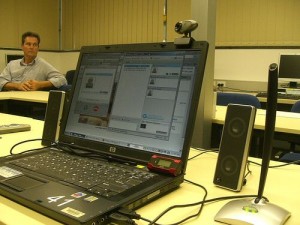
A well-performing virtual team makes effective use of a wide range of collaboration tools. After the various forms of communication discussed in my last post, any self-respecting virtual project team must have access to a decent desktop sharing tool. In the past few years, the options and quality available here have grown significantly. To work well for a virtual team, your desktop sharing tool should have most (ideally, all) of these key features:
Must Have
- Fast and simple process to get connected to a session (< 5-10 secs)
- Share with up to 10 people with no performance impact
- Connect people across firewalls
- Integrated whiteboard for brainstorming and note-taking
- Snapshots and mark-up the resulting image
- Save mark-ups in a standard file format for distribution to others
- Lightweight client-side component that installs quickly and simply
- Fast and simple switch between desktops being shared
Want
- Integrates with a mainstream IM client (or at least has its own built-in)
- Has a list of who is in the session
- Has a hands-up queue for managing questions in larger groups
- Is secure (encrypted stream)
- Can share more then one person’s desktop at the same time
Of course, none of the tools available today have all of these features, so you must make tradeoffs for your particular situation.
For this post I will not talk about the large providers of desktop sharing that charge for their service, such as Microsoft Live Meeting, WebEx, and GoToMeeting. I will instead discuss some recent experience I’ve had with a few of the free desktop sharing applications I have found. If you have had some experience with a tool you like, please comment on this post. I’d very much like to hear what you have found useful.
Note: I have included a comment about Linux compatibility, as this is a platform used by many of my colleagues and thus important for my particular collaboration needs. Since Microsoft Windows is the primary desktop used by most, this probably will not be an issue for you. However, I’ve found that although most of my colleagues do have access to a Windows PC, all it takes is one ‘purist’ on Linux who can’t contribute during a meeting to have the effectiveness of the session drop dramatically.
This is Microsoft’s answer to NetMeeting-through-firewalls, but without the voice or instant messaging. It is relatively easy to connect to another Windows user (but not perfect as I’ve had problems connecting with some people);
Pros: Has the usual Microsoft polish, so it is easy to use and attractive; up to 15 people can share;
Cons: No whiteboard; Does not work with Linux (no surprise here)
This is a very nicely done tool that integrates a free phone conferencing service and whiteboard along with a desktop sharing engine. The service provides persistent storage of session data so that your team can come back and update the contents. Unfortunately, it does not work on the Linux platform (at least not natively).
Pros: Excellent whiteboard for multi-user collaboration (one of the better ones I’ve used); Persistent content
Cons: Does not work with Linux.
Yes, Skype includes a very simple desktop sharing feature to compliment its rather impressive voice and video sharing. The feature appears to be implemented as a compressed video stream and is sent in place of a video channel.
Pros: Very easy to start a desktop sharing session once you find with switch (call > “share your screen” > “share full screen”); Fast to share, once you have the Skype connection established;
Cons: Works only between two people; Does not work with Linux (yet?); You cannot take control of a shared desktop, so remote support is not as easy; The compressed video stream has poor resolution, making it difficult for someone on a small screen to read text on another PC.
Although somewhat complex in its installation and usage, this is a very nice tool for small team collaboration. I really like the on-screen mark-up (they call it a whiteboard, but it isn’t really) where you can draw over anything on your screen. It handles up to 10 participants.
Pros: Attractive; interesting features; excellent fidelity of desktop image.
Cons: Does not work on Linux (Windows and Mac only); screen sharing starts immediately unless you configure it otherwise; there is no obvious indication you are sharing your screen.
These are not necessarily the best nor the only desktop sharing solutions available…just the ones I’ve come across lately or have had some experience with. In fact, desktop sharing appears to be quite a hot area now with products popping up all over the place. Some other names to check out: yugma.com, teamviewer.com, and yuuguu.com. I’ve not had a chance to play with these, but they look interesting.
If your virtual team does not make use of the desktop sharing tool, I would love to hear from you why not. Being able to share desktops in a virtual meeting is a must-have for all project teams.
In my next post I will talk about my recent experiences with a few of the popular virtual whiteboard tools.

Just a quick follow-up, I’m part of the Yuuguu Dev Team and it would be great if you did get a chance to look at our collaboration software as it is always good to get feedback.
We don’t feature white-boarding nor saving sessions (yet!) but we are cross platform (PC, Mac & Linux) and we integrate with your existing IM networks so bringing people together is quick and simple.